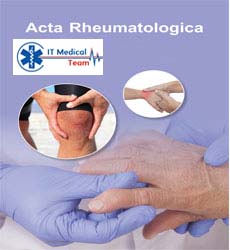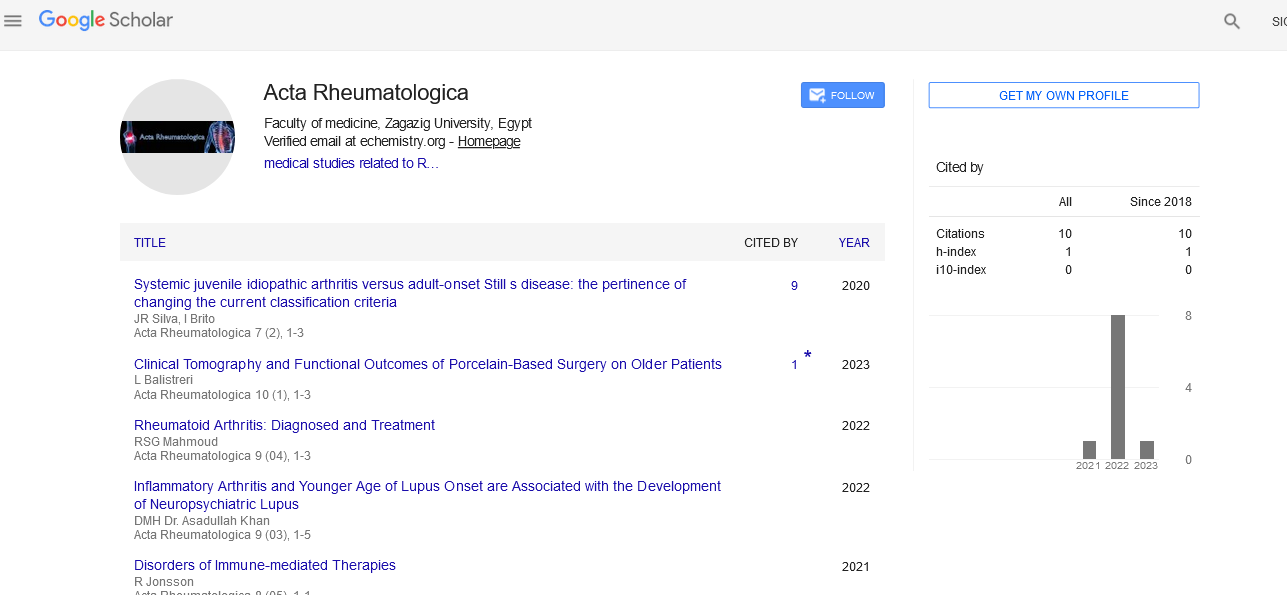Case Report - (2023) Volume 10, Issue 4
Understanding Psoriatic Arthritis: Symptoms, Causes, and Management
Xiaoya Zhang*
Department of Healthcare and Medicine, Japan
*Correspondence:
Xiaoya Zhang, Department of Healthcare and Medicine,
Japan,
Email:
Received: 03-Aug-2023, Manuscript No. ipar-23-14038;
Editor assigned: 05-Aug-2023, Pre QC No. ipar-23-14038(PQ);
Reviewed: 19-Aug-2023
Revised: 22-Aug-2023, Manuscript No. ipar-23-14038(R);
Published:
28-Aug-2023
Abstract
Psoriatic arthritis, a chronic autoimmune disorder closely associated
with psoriasis, presents a complex interplay of symptoms, causes,
and management strategies. This article provides an overview of this
condition, highlighting its distinctive symptoms including joint pain,
skin changes, and fatigue. The genetic and environmental factors
contributing to its onset are explored, with genetic predisposition and
triggering events playing pivotal roles. Diagnosis involves a combination
of clinical evaluation, medical history, and imaging techniques,
while management encompasses a range of options. These include
medications, physical therapy, lifestyle adjustments, and surgical
interventions. A holistic approach focusing on early detection and
personalized treatment is crucial for enhancing the quality of life for
those affected by psoriatic arthritis.
Keywords
Psoriatic arthritis; Symptoms; Management; Autoimmune
disorder; Psoriasis
INTRODUCTION
Psoriatic arthritis, a chronic and intricate autoimmune
condition, stands as a significant challenge for both
medical professionals and individuals affected by it.
With its strong association with psoriasis, a skin disorder
marked by distinctive red, scaly patches, psoriatic arthritis
weaves together a complex tapestry of symptoms, causes,
and management strategies [1]. This article embarks on a
journey to unravel the layers of understanding surrounding
this condition, shedding light on the diverse symptoms
it presents, delving into the intricate web of factors
contributing to its onset, and exploring the various avenues
for effective management [2]. As we delve into the depths
of this multifaceted topic, a clearer picture emerges of how
psoriatic arthritis impacts lives and how advancements in
its diagnosis and treatment are offering hope for enhanced
well-being and improved quality of life.
DISCUSSION
Psoriatic arthritis is a chronic autoimmune condition that
affects millions of people worldwide. It is closely linked
to psoriasis, a skin condition characterized by red, scaly
patches. Psoriatic arthritis can lead to joint pain, stiffness,
and swelling, significantly impacting a person's quality of
life [9]. In this article, we will delve into the symptoms,
causes, diagnosis, and management of psoriatic arthritis,
shedding light on this often misunderstood condition.
Symptoms
Psoriatic arthritis presents a wide range of symptoms that
can vary from person to person. Common signs include:
Joint pain and swelling: Psoriatic arthritis primarily targets
the joints, causing pain, swelling, and stiffness. This often
leads to reduced joint mobility and difficulty performing
everyday tasks [3].
Skin changes: Individuals with psoriatic arthritis usually
have psoriasis, which manifests as red, scaly patches on the
skin. These patches can be itchy and painful.
Nail abnormalities: Psoriatic arthritis can cause changes in
the nails, including pitting, discoloration, and separation
from the nail bed.
Fatigue: Many people with psoriatic arthritis experience
fatigue that can be quite debilitating.
Eye inflammation: In some cases, inflammation can affect
the eyes, leading to redness, pain, and sensitivity to light.
Swollen fingers and toes: Psoriatic arthritis can cause
swelling of the fingers and toes, leading to a "sausage-like"
appearance.
Causes
The exact cause of psoriatic arthritis is not fully understood,
but it is believed to be a combination of genetic and
environmental factors. Genetic predisposition plays a
significant role, as having a family history of psoriasis or
psoriatic arthritis increases the risk [4]. Certain triggers,
such as infections or injuries, can also prompt the immune
system to attack the body's own tissues, leading to the
development of the condition.
Diagnosis
Diagnosing psoriatic arthritis can be challenging, as its
symptoms often overlap with other types of arthritis.
Medical professionals typically consider a combination of
factors, including a physical examination, medical history,
and imaging tests like X-rays and MRI scans [5]. The
presence of psoriasis and nail abnormalities can also aid in
diagnosis.
Management
While there is no cure for psoriatic arthritis, there are
various treatment options available to manage its symptoms
and improve quality of life:
Medications: Nonsteroidal anti-inflammatory drugs
(NSAIDs), disease-modifying antirheumatic drugs
(DMARDs), and biologic therapies can help reduce
inflammation, pain, and slow disease progression [6].
Physical therapy: Physical therapists can design exercise
routines to improve joint mobility, strengthen muscles, and
alleviate pain [7].
Lifestyle modifications: Maintaining a healthy weight,
managing stress, and getting regular exercise can help
manage symptoms.
Topical treatments: Skin-related symptoms of psoriasis
can be treated with topical creams, ointments, and light
therapy [8-10].
Surgery: In severe cases, surgery may be recommended to
repair or replace damaged joints.
CONCLUSION
In conclusion, the intricate nature of psoriatic arthritis
becomes apparent as we unravel its multifaceted
dimensions. This condition, intricately linked with
psoriasis, demonstrates its ability to challenge both medical
understanding and the daily lives of those affected. By
comprehending the diverse array of symptoms it presents,
from joint pain to skin changes and beyond, we gain
insight into the breadth of its impact. The interplay of
genetic predisposition and environmental triggers further
underscores the complexity of its origins. However, in this
complexity lies the promise of better management. With
an array of treatment avenues ranging from medications
and physical therapy to lifestyle adjustments and surgical
interventions, individuals can find tailored approaches
that suit their unique circumstances. As medical science
continues to advance, early detection and personalized
treatment strategies are becoming increasingly attainable,
offering hope for improved quality of life and a brighter
future for those navigating the challenges of psoriatic
arthritis.
REFERENCES
- Leffler CT, Philippi AF, Leffler SG, et al. Glucosamine, chondroitin, and manganese ascorbate for degenerative joint disease of the knee or low back: a randomized, double-blind, placebo-controlled pilot study. Mil Med. 1999; 164(2): 85-91.
Indexed at, Google Scholar, Crossref
- Houpt JB, McMillan R, Wein C, et al. Effect of glucosamine hydrochloride in the treatment of pain of osteoarthritis of the knee. J Rheumatol. 1999; 26(11): 2423-30.
Indexed at, Google Scholar, Crossref
- Demicco EG, Park MS, Araujo DM. Solitary fibrous tumor: a clinic pathological study of 110 cases and proposed risk assessment model. Mod Pathol. 2012; 25(9): 1298-1306.
Indexed at, Google Scholar, Crossref
- Park MS, Patel SR, Ludwig JA. Activity of temozolomide and bevacizumab in the treatment of locally advanced, recurrent, and metastatic hemangiopericytoma and malignant solitary fibrous tumor. Cancer. 2011; 117(21): 4939-4947.
Indexed at, Google Scholar, Crossref
- Roughley PJ, Mort JS. The role of aggrecan in normal and osteoarthritic cartilage. J Exp Orthop. 2014; 1(1): 8.
Indexed at, Google Scholar, Crossref
- Jerosch J. Effects of Glucosamine and Chondroitin Sulfate on Cartilage Metabolism in OA: Outlook on Other Nutrient Partners Especially Omega-3 Fatty Acids. Int J Rheumatol. 2011; 2011: 969012.
Indexed at, Google Scholar, Crossref
- Imagawa K, de Andrés MC, Hashimoto K, et al. The epigenetic effect of glucosamine and a nuclear factor-kappa B (NF-kB) inhibitor on primary human chondrocytes-implications for osteoarthritis. Biochem Biophys Res Commun. 2011; 405(3): 362-367.
Indexed at, Google Scholar, Crossref
- Vallat-Decouvelaere AV, Dry SM, Fletcher CD. Atypical and malignant solitary fibrous tumors in extrathoracic locations: evidence of their comparability to intra-thoracic tumors. Am J Surg Pathol. 1998; 22(12): 1501-1511.
Indexed at, Google Scholar, Crossref
- Cranshaw I, Gikas P, Fisher C. Clinical outcomes of extra- thoracic solitary fibrous tumours. Eur J Surg Oncol. 2009; 35(9): 994-998.
Indexed at, Google Scholar, Crossref
- Jones IA, Togashi R, Wilson ML, et al. (2019) Intra-articular treatment options for knee osteoarthritis. Nat Rev Rheumatol. 2019; 15(2): 77-90.
Indexed at, Google Scholar, Crossref





